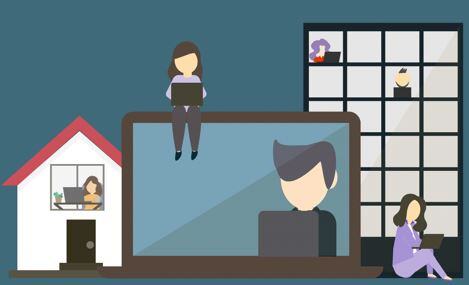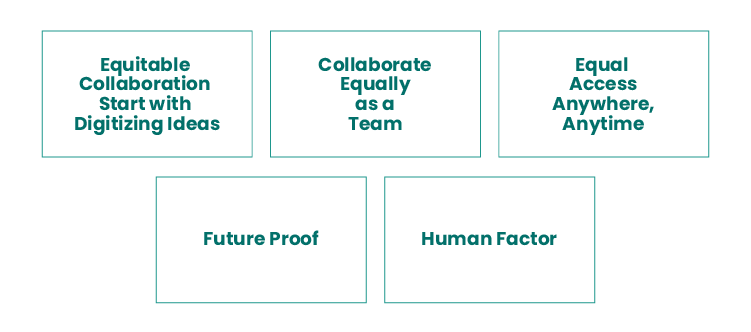The hybrid work model combines employees working in-office and remotely. This way of working provides companies and employees with new workflow flexibility; by erasing physical location and time-zone constraints.
The hybrid work model is challenging companies to think and work differently. By successfully overcoming physical barriers, companies can realize added productivity. On the other hand, companies that fail to adapt will see productivity drop. They will simply go back to the old way of doing business, never taking advantage of the new opportunities that hybrid working provides. For companies to transition successfully, key factors help guide them through the change.

Equitable Collaboration
The fundamental challenge for any hybrid work is maintaining or enhancing creativity and productivity when team members are working from different physical locations. A key factor is maintaining an “equitable collaboration.” In an equitable collaboration, whether in-office or remote, employees have equal voices and contributions. If remote participants cannot contribute equally with in-room peers, the hybrid transition will quickly fail.
Does your organization have the right processes and tools to offer an equitable collaboration experience?
Hybrid work: What is required for Equitable Collaboration?
Each company has its own unique culture, people and processes. Therefore, no single solution fits every organization. Yet, there are common factors to be considered.
1. Equitable collaboration starts with digitizing ideas
Whether you are brainstorming, creating a new design or running a project, these ideas must be transformed from a physical notebook or in-room whiteboard into a sharable digital tool. In the meeting room, InGlass™ interactive displays are essential in digitizing meeting content into an online whiteboard that is viewable and shareable. Any digital capturing tool must be intuitive to use, or the transformation will collapse. The hybrid transformation starts with capable digital tools that are natural and easy to use.
2. Collaborate equally as a team
Digitizing your Whiteboard, Kanban, Workshop or anything in between is a necessary step in developing an equitable collaboration. Yet, it is not sufficient on its own. Once in place, the team must leverage the digital content for collaboration. To do that, organizations invest heavily in video conferencing tools. However, many organizations neglect the most basic and natural office collaboration device: the dry-erase board.
You can digitize the in-room whiteboard experience using digital whiteboard software such as FlatFrog Board, but you also need to ensure real-time equitable collaboration. Every member of the team must be able to contribute to the board using annotation, sticky notes, priority icons and more. The collaboration experience for remote users must match the in-room participants' experience. Many elements nourish team collaboration, but having a capable collaborative tool for hybrid participants is a required piece.
3. Equal access anywhere, anytime
Equitable collaboration takes place both in and outside the meeting. It may require remote employees in different locations and time zones to contribute before or after the meeting. Every member of the team can have access to the working files from anywhere at any time. This is a significant advantage over in-room boards where content is only available inside the physical meeting room. And with digital access control, the meeting host can manage what and when to share. Equitable file access enables each person to contribute from inside or outside the physical meeting room, with the added benefit of keeping content digitally secured with managed file access.
4. Future proof
The demands of hybrid teams are still evolving. Therefore, whichever platform a company uses must be flexible enough to handle all types of work. Meetings may be ad-hoc or they may be planned. Collaborative teams may brainstorm, invent, plan or track projects. Teams and the tools they use must be flexible enough to accommodate a wide range of users and use cases. Platform-agnostic collaborative whiteboards provide functionality and flexibility without locking them into a specific videoconferencing platform.
5. Human factor
Hybrid teams require the right tools for equitable collaboration. In addition, significant human factors are essential in a successful transformation. Are managers leading by example? What training is required? Are there processes in place to encourage digital work documentation by employees?
These are some of the most basic questions that hybrid companies need to consider. Acquiring the right tools is only the first step in creating more productive teams. Without the correct collaborative tool, such as a capable hybrid whiteboard, further transition will fail.
Summary
Many organizations are adapting to hybrid work. The transition to a truly equitable collaboration requires a cultural shift, leadership, processes, and more capable digital tools, whether in the office or remote. A successful transition replaces physical location barriers with functional and agile workflows, benefiting both employees and the company. And the digital transformation journey starts with a new brand of hybrid whiteboards.

FlatFrog
FlatFrog is a provider of free online whiteboards (app.flatfrog.com).
FlatFrog has also designed patented InGlass™ touch display technology from the ground up, providing the best pen and touch input to mimic the intuitive feeling of a dry-erase board. InGlass™ touch displays are available through our partners, including Dell, Google, Samsung, SMART, Sharp, Ricoh, Avocor, CTOUCH and more (www.flatfrog.com/partners).


